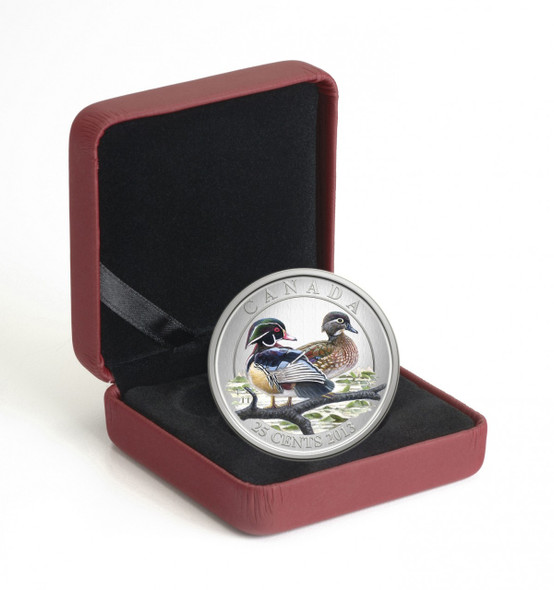Description
Theme:
Celebrating 75 Years of Ducks Unlimited Canada: The Mallard—Icon of Canadian Wetlands
Description:
This silver 10-dollar coin measures 34 millimetres and weighs 15.87 grams. The reverse image by Canadian artist Trevor Tennant features a mallard pair walking together along the snow-dusted shore of a Canadian waterway in late autumn, preparing themselves, perhaps, for the first leg of their migratory journey to warmer climes. Softly camouflaged by the tall reeds and other wetland vegetation lining the iced-over pond, the mottled brown-and-white hen steps forward, one foot raised to her belly—perhaps to be warmed by the downy feathers there. Her reflection is visible in the ice below. The drake, standing just behind and beside his mate, glances out across the unseen waterway as he steps carefully over a bed of snapped, snow-covered reeds that overspill the bounds of the raised circular frame surrounding the image. Engraved with the face value, “10 dollars” and “Canada 2013.” The obverse features the effigy of Her Majesty Queen Elizabeth II by Susanna Blunt.
Special Features:
- This stunning silver 10-dollar coin features a mallard pair at the onset of fall migration showcased in full colour.
- The first coin in a new series featuring Ducks of Canada. Future coins include the wood and the pintail ducks.
- A unique opportunity to celebrate the 75th anniversary of Ducks Unlimited Canada with a keepsake whose aesthetic appeal stands on its own.
- For 75 years, Ducks Unlimited Canada has been committed to wetland conservation, delivering science-based habitat projects as well as research, education and policy programs.
- The pure silver of the finely wrought coin perfectly captures the crisp chill of this iconic moment in the cycle of Canada’s seasons.
- Melding the Royal Canadian Mint’s world-renowned artistry and craftsmanship, this coin is an excellent gift for bird aficionados, conservationists, nature lovers, and collectors of beautiful and unique coins.
Specifications
Face Value: $10
Mintage: 10,000
Composition: 99.99% fine silver
Weight (g): 18.87
Diameter (mm): 34
Edge: Serrated
Finish: Proof
Certificate: Serialized
Artist: Trevor Tennant
Complete Certificate Text:
Celebrating 75 Years of Ducks Unlimited Canada:
The Mallard—Icon of Canadian Wetlands
A mallard pair floating placidly on still waters is an iconic Canadian image. Abundant throughout North America, the mallard (Anas platyrhynchos) is one of the continent’s most well-known and best-loved species of wild duck. One of the first to return to its home nesting grounds after winters spent in ice-free regions of the continent, this large surface-feeding, or “dabbling,” waterfowl is the species from which most domestic ducks originated.
The plumage of mallards is instantly recognizable. The male, or drake, has a bright green head, ochre yellow bill, and brown chest. He bear patches (known as “specula”) of indigo blue on its greyish, brown wings. On the other hand, the female, or hen, bears mottled brown and white plumage, sharing with the drake a striking indigo speculum decorating the upper back edge of each wing.
The mallard’s preferred habitats include wetlands, ponds, and prairie “potholes”— marshy areas where they can raise their ducklings in relative safety. These habitats provide plenty of vegetation, seeds, and nutrient-rich invertebrates to sustain the mallard’s varied diet throughout its life cycle.
Mallard mating pairs travel together from their wintering grounds to their home breeding territory in early spring. Mallard hens will lay an egg a day for up to 12 days, incubating the eggs for about a month. Within one day of hatching, the mother leads her ducklings to the safety of nearby water. The ducklings will remain with their mother for approximately two months, until they learn to fly and can begin the age-old lifecycle of migrating, selecting a mate, and breeding.
Conserving Canadian Wetlands for 75 Years: Ducks Unlimited Canada
The wetland habitats mallards depend on in Canada are at serious risk. We need immediate action to conserve wetlands – the natural areas where mallards and other waterfowl breed and raise their young – to ensure iconic Canadian moments like the one captured on this coin continue for years to come. In Canada, we lose 80 acres of wetlands every day. Without ongoing support from all Canadians, these essential areas may disappear. For 75 years, Ducks Unlimited Canada has been committed to wetland conservation, delivering science-based habitat projects as well as research, education and policy programs. You can continue the rich history of wetland conservation in Canada and help write a new chapter for waterfowl like the mallard.
















